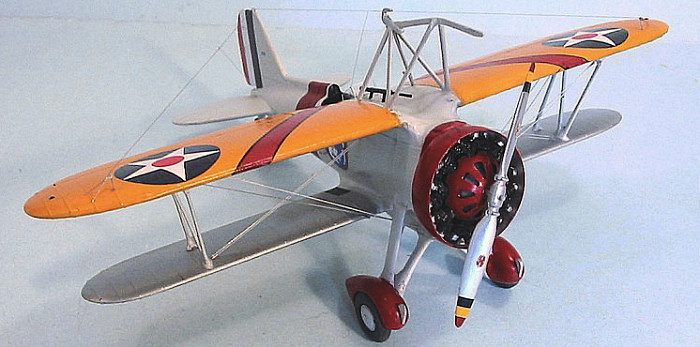
| KIT #: | ? |
| PRICE: | $19.95 MSRP |
| DECALS: | all options |
| REVIEWER: | Tom Cleaver |
| NOTES: | Short run |

| HISTORY |
The Curtiss F9C-2 Sparrowhawk biplane fighters gained fame all out of proportion to their small number. The type has interested modelers for 74 years now, ever since the six actual airplanes were first delivered to the U.S. Navy to operate from the dirigibles U.S.S. “Akron” and U.S.S. “Macon,” which had been ordered in October 1928 from the Goodyear Zeppelin Corporation of Akron, Ohio. Originally known to the public as “Akron fighters,” since they all were serving with the “Akron” at Lakehurst, New Jersey, which was close enough to New York City for them to be widely publicized. The first kits were released by the Cleveland Model Corporation the following year, and there has never been a year since when a modeler could not get a kit of the airplane, be it a stick-and-paper model, a radio-controlled flying model, or an injection-molded plastic kit in at least two scales. I first built a Guillow “stick-and-paper” kit of the Sparrowhawk when I was in elementary school, which was - mumblemumble - a long time ago.
Dirigibles to this day seem to exercise some special hold on the aeronautical
imagination, despite the manifest failure of the concept when it was first
advertised as the “dreadnought of the sky” during the First World War, and the
fact that all but two of those built after the war by four different countries
were destroyed in major accidents that held the public imagination for years (if
you consider the destruction of the “Hindenburg,” the memory has become
immortal). Despite losing the U.S.S. “Shenandoah” in 1924, and never finding
much operational success with the U.S.S. “Los Angeles” acquired from Germany
shortly afterwards, it 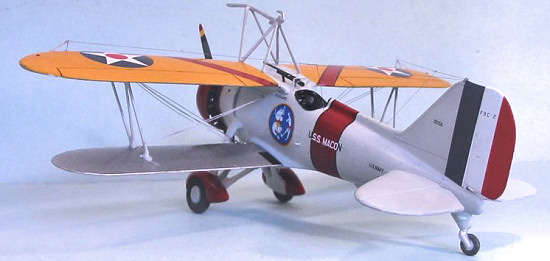 seemed to
many in Naval Aviation that the rigid airship could play an important role since
American military policy was defensive in orientation between the world wars.
The “Akron” and the “Macon,” were intended to operate as airborne coastal
defense scouts, keeping watch over the approaches to the United States with
their extended range and endurance. The two airships were 785 feet long with a
range of over 9,000 miles and the ability to remain airborne for days at a time.
They used non-flammable helium to achieve their lighter-than-air status, unlike
the hydrogen that had been turning German Zeppelins into flying explosions since
1915.
seemed to
many in Naval Aviation that the rigid airship could play an important role since
American military policy was defensive in orientation between the world wars.
The “Akron” and the “Macon,” were intended to operate as airborne coastal
defense scouts, keeping watch over the approaches to the United States with
their extended range and endurance. The two airships were 785 feet long with a
range of over 9,000 miles and the ability to remain airborne for days at a time.
They used non-flammable helium to achieve their lighter-than-air status, unlike
the hydrogen that had been turning German Zeppelins into flying explosions since
1915.
Originally, the concept of basing small aircraft aboard the two dirigibles was to provide defense. However, since they were only able to carry five such aircraft - which were really insufficient to be of much use for aerial defense - it was decided instead that airship itself would remain out of harm’s way while launching the smaller aircraft to serve as scouts for the battle fleet.
The XF9C-1 originated with a May 1930 specification for a small aircraft carrier-based fighter. The resulting XF9C-1, BuNo 8731, was built under a June 1930 contract and delivered in March 1931. Tested through that year, it demonstrated good performance but was not particularly suitable for use from an aircraft carrier. However, the plane did have one significant feature: it was the only available combat airplane small enough to fit through the hangar door of the Akron, which was then nearing completion. The XF9C-1 was modified with a "skyhook" that would allow launching and recovery from the airship's "trapeze" airplane handling device, and first "landed" on the U.S.S. :Los Angeles” in October 1931. It was actively employed in developmental operations with the “Akron.”
The success of the XF9C-1 in this new role resulted in the construction of seven
modified airplanes: the XF9C-2, BuNo 9264 - which was a 1931 private Curtiss
project that was purchased by the Navy in November 1932 - and six production
F9C-2s, BuNos 9056-9061), built under an October 1931 contract and the only "Sparrowhawks"
suitable for operational use. The p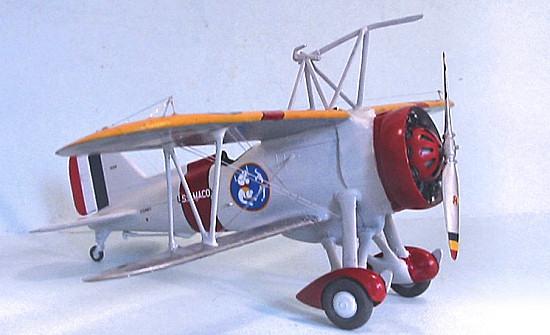 roduction F9C-2 was powered by a 438 h.p.
Wright R-975E-3 Whirlwind radial engine, providing a maximum speed of 176.5 mph,
with an initial climb rate of 1,690 feet per minute. Service ceiling was 19,200
feet, with a range of 297 miles. Armament was two 30-cal machine guns
synchronized to fire through the propeller arc.
roduction F9C-2 was powered by a 438 h.p.
Wright R-975E-3 Whirlwind radial engine, providing a maximum speed of 176.5 mph,
with an initial climb rate of 1,690 feet per minute. Service ceiling was 19,200
feet, with a range of 297 miles. Armament was two 30-cal machine guns
synchronized to fire through the propeller arc.
The first flew in April 1932 and began work with a hook-up to “Akron” on June 29. Further modifications resulted and all six F9C-2s were delivered by September 1932. They worked with “Akron” from Lakehurst until the airship was lost April 4, 1933. The F9C-2s were then transferred to the heavier-than-air unit of “Macon,” which was nearing completion. Operating on the Pacific Coast at Moffett Field in the San Francisco Bay Area from late 1933 until the “Macon” was lost February 12, 1935, they were used in efforts to demonstrate the dirigible’s value as a unit of the United States Fleet.
When “Macon” crashed at sea on February 12, 1935, four of the F9C-2s were lost with her. The two survivors, BuNos 9056 and 9057, were subsequently used in Fleet utility work, with 9057 disposed of in 1937. BuNo 9056 remained in service until 1940, when it was transferred to the Smithsonian Institution for preservation as a museum artifact. The XF9C-1 had been surveyed in 1936, while the XF9C-2 was wrecked that same year.
BuNo 9056 had been rebuilt from the best parts of the surviving F9C-2s. When it was first set up for exhibit at the Smithsonian, it carried the unit markings of the U.S.S. Akron. In 1970, the Potomac Chapter of the Antique Airplane Association, under the supervision of the National Air and Space Museum, restored the F9C-2 as a group project. With restoration completed in 1974, the Sparrowhawk emerged in the markings of the U.S.S. “Macon” unit to which 9056 had been assigned.
Not only is BuNo 9056 the last surviving Sparrowhawk, it is the only survivor of all the fighters built by Curtiss from 1928-38, that formed the backbone of fighter aviation for the Army Air Corps and the U.S. Navy during the “Golden Wings” era. (An interesting note is that these planes were designed to operate without landing gear, the theory being that it would increase their speed and since their carrier was always airborne, landing gear were not needed. Aside from a test flight or two, I believe they all went through their short lives with the safety of landing gear. Ed)
| THE KIT |
Williams Brothers first released their kit of the F9C-2 in around 1976-77, if
memory serves. This was shortly after the restoration of BuNo 9056 and its
display at the Smithsonian, and much was made at the time that they had access
to the original airplane for taking measurements and creating the design. The
kit was in limited production for the next 30-some years, until Williams
Brothers 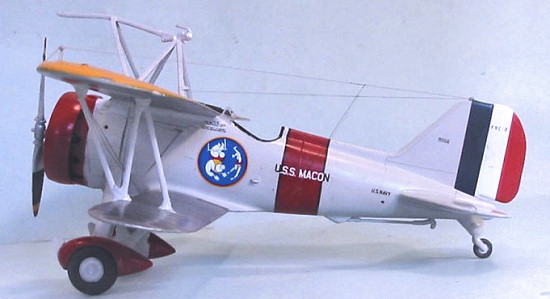 went out of business in 2005, and was generally considered one of the
better releases from this hit-or-miss company.
went out of business in 2005, and was generally considered one of the
better releases from this hit-or-miss company.
Williams Brothers kit have never been considered easy projects. They should be thought of as limited-run kits, since their production quality is about at the same level achieved by MPM some ten years ago.
Molded in a soft light-grey plastic, the F9C-2 provides good fabric detail on the wings, and a cockpit with molded-on detail that would benefit from detailing with scratchbuilt throttle and other parts.
The decal sheet provides serials for all six F9C-2s, and markings for both the “Akron” and “Macon” aircraft units.
There is some hope that the F9C-2, along with the rest of the line of kits, will be put back into production and re-released in the future, now that the company has been purchased by a new owner.
| CONSTRUCTION |
Having taken every opportunity over the past 30 years to not buy this kit while it was in production, I became nostalgic for it last year when the company went out of business, but was not terribly interested in paying eBay prices for it. When the late lamented Tony & Addie’s Hobby Lobby went out of business this past March, Tony put out several kits he had kept in his personal stash, offering them at original prices. There were several Williams Brothers kits, including this F9C-2, all priced at $19.85, and I took the opportunity to pick up this Sparrowhawk, the P-35, and the GeeBee Model Z.
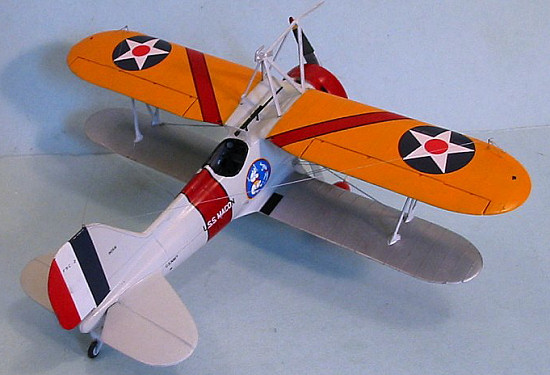 Opening the box, I realized I had purchased the kit at exactly the right time,
since I now had 14 years’ experience building difficult Eastern European
limited-run kits, which meant that the “difficult” description of this kit would
not be that personally problematic.
Opening the box, I realized I had purchased the kit at exactly the right time,
since I now had 14 years’ experience building difficult Eastern European
limited-run kits, which meant that the “difficult” description of this kit would
not be that personally problematic.
Once I cleaned up the flash from the parts, I proceeded to assemble the wings, which went together easily. I then started on the fuselage. The cockpit is quite basic, and I supplemented things with a scratchbuilt throttle better than the part provided in the kit, and the kit seat from a Trumpeter P-40B that was the right size and looked a lot better than what was in the kit. I also attached the forward part, where the engine fitted.
Looking at how the model would be marked, I decided it would be a good idea to assemble the cowling and the engine, so that I could attach the cowling to the fuselage for painting.
When the fuselage was finished, I attached the upper wing sub assembly. This required a lot of cutting, sanding and shaping to get the fit right. The lower wings were much easier, and I also cleaned up and attached the interplane “N” struts. When I assembled the horizontal stabilizers, I noticed a lot of sink on both upper and lower surfaces. This was filled with putty and sanded smooth, and then I used copious amounts of Mr. Surfacer on all the seams and joints of the whole model.
I then set the engine in position and attached the cowling around it. When that was set, I could pull out the engine so that I would be able to paint the forward fuselage without worrying about the engine.
The landing gear was difficult, to say the least, using lots of cyanoacrylate glue and Mr. Surfacer to assemble each and clean them up. When they were complete, I attached them to the model.
| COLORS AND MARKINGS |
Painting:
I
first painted the model flat white overall. Then I painted the lower surface of
the upper wing and the lower wings with SNJ Aluminum. When that was dry, I
masked off these surface and then masked off and painted the red forward
fuselage and engine cowling, the wing chevrons and the fuselage band, and the
wheel pants, using Gunze-Sangyo gloss Insignia Red. I then masked
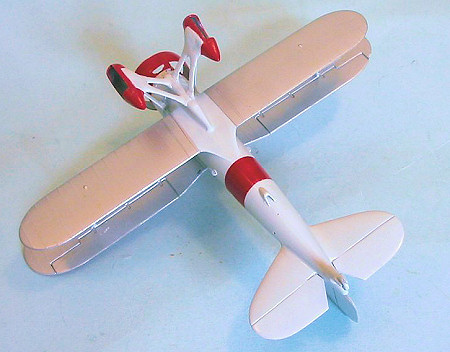 these areas
off, and painted the upper wing with Gunze-Sangyo Orange Yellow. I then masked
that off when dry, and painted the fuselage with Xtracrylix Light Grey FS
16622. Fortunately, Xtracrylix paints will dry the same color whether
airbrushed or hand-painted, so I hand-painted the struts of the landing gear
around the wheel pants rather than try and mask off that complicated area, and
hand painted the N-struts and the panels on the lower surface of the upper wing
that covered the flotation bags.
these areas
off, and painted the upper wing with Gunze-Sangyo Orange Yellow. I then masked
that off when dry, and painted the fuselage with Xtracrylix Light Grey FS
16622. Fortunately, Xtracrylix paints will dry the same color whether
airbrushed or hand-painted, so I hand-painted the struts of the landing gear
around the wheel pants rather than try and mask off that complicated area, and
hand painted the N-struts and the panels on the lower surface of the upper wing
that covered the flotation bags.
I then gave the model a coat of Xtracrylix Gloss varnish.
Decals:
I had decided at the outset to do BuNo 9056, the sole surviving F9C-2, which was also the airplane depicted on the box art.
The first thing I discovered is that the black border decals for the wing strips and fuselage band were far too narrow, so I replaced them with surplus black stripe decal from the Accurate Miniatures F3F-2 kits. The rest of the kit decals went down without problem.
| FINAL BITS |
I gave the model a good coat of Xtracrylix Satin varnish, then proceeded to do the rigging with .010 wire. The radio masts on the wing were also made with .010 wire, and the antenna wire was done with nylon repair thread. The prop was painted with SNJ aluminum and then polished with SNJ polishing powder, with the blue-yellow-red tip stripes coming from a Yellow Wings Decals sheet. The windscreen was made from spare clear plastic sheet.
| CONCLUSIONS |
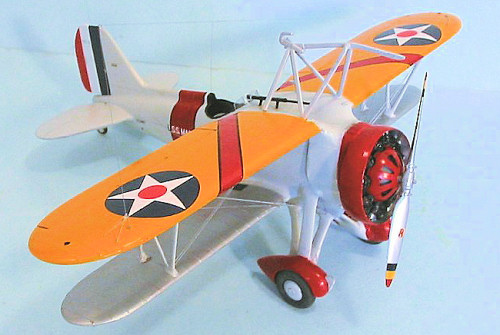 Definitely not a project for a beginner, but anyone with a few eastern European
limited-run kits under their belt will have no problem with this kit.
Definitely not a project for a beginner, but anyone with a few eastern European
limited-run kits under their belt will have no problem with this kit.
The end result is a beautiful model (even with the mistakes I know are there on this one) of one of the most interesting airplanes from the Golden Wings era. This kit is the most accurate of any of the other plastic kits of the Sparrowhawk available, both of which are 1/72 limited run monsters that make this kit seem like a Tamiya kit in comparison.
These kits can be found on dealer’s tables at shows, and are worth the effort to get them. Since Williams Brothers has been purchased by a new owner who has announced a plan to re-release the kits, only an idiot would pay eBay prices for this rather than wait for the new release (but then the idiots at eBay are unlikely to ever listen to reason from anyone).
May 2006
Kit courtesy of my wallet.
If you would like your product reviewed fairly and fairly quickly, please contact the editor or see other details in the Note to Contributors.